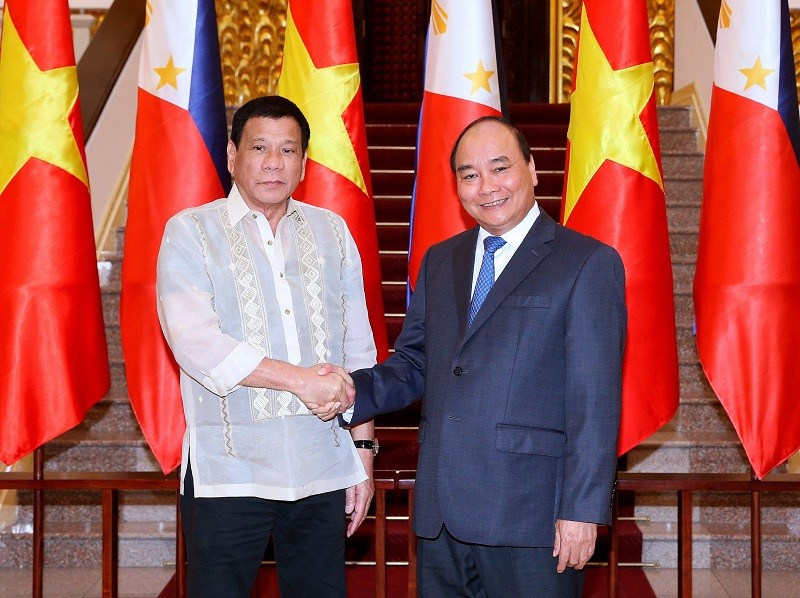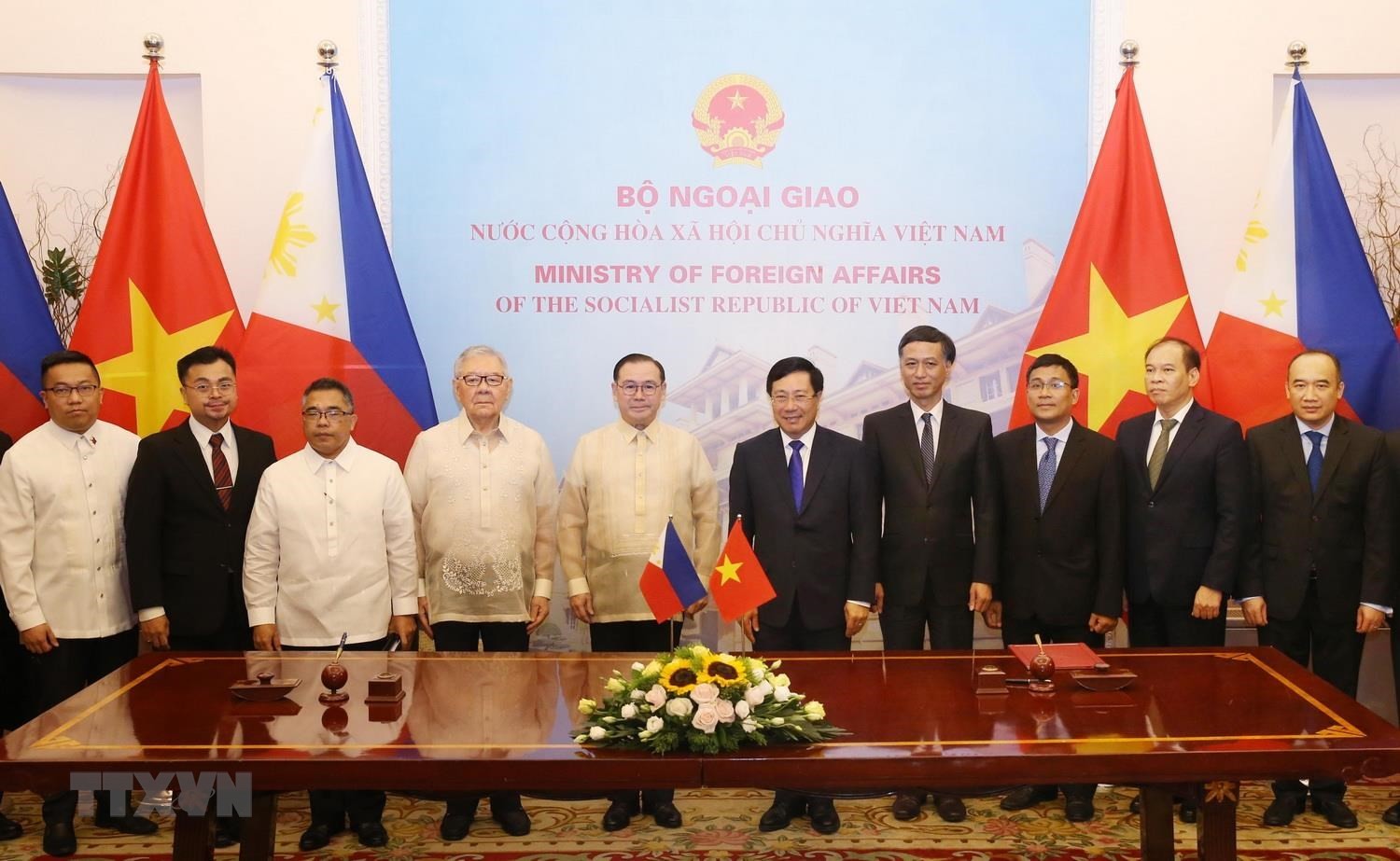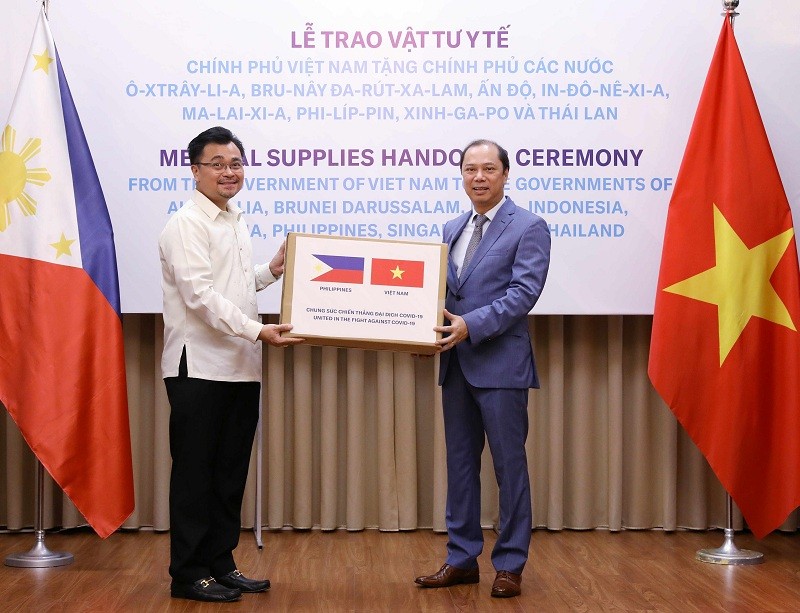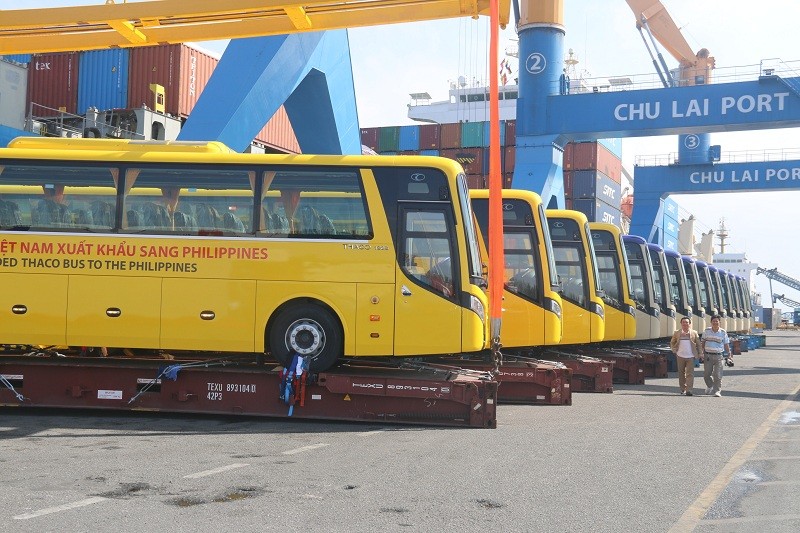
Viet Nam - Philippines Strategic Partnership: Firmly advancing towards the future
Latest
What are the highlights of the Viet Nam – Philippines relations over the last 45 years?
Viet Nam and the Philippines enjoy a time-honored traditional friendship. There had been contacts and commercial exchanges between the two countries dating back centuries. On July 12th, 1976, the two countries issued a Joint Communique on the establishment of diplomatic relations, making the Philippines the fourth ASEAN country to establish formal diplomatic ties with Viet Nam.
 |
| Vietnamese Prime Minister Nguyen Xuan Phuc met with Philippine President Rodrigo Roa Duterte in Ha Noi, on September 29th, 2016. (Photo: TTXVN) |
The Philippines is also one of the first ASEAN Member States to sign a Trade, Scientific and Technological Cooperation Agreement with Viet Nam (January 9th, 1978), laying the legal framework for bolstering collaboration and exchanges between the two countries thereafter.
Most notably, the upgrading of relations to the Strategic Partnership (November 17th, 2015) opened up a new chapter in the relationship between Viet Nam and the Philippines, making it more comprehensive, broader and deeper in scope and substance, within both bilateral and multilateral frameworks.
The opportunities and potential for cooperation between the two countries have since been transformed into concrete deliverables in a wide range of areas, from political and diplomatic cooperation, trade and investment, and security and defense, to educational, cultural, tourism and people-to-people exchanges. The two countries also enjoy successful collaboration at regional and international organizations and forums.
The political and diplomatic relations between the two countries have been further strengthened. Political trust is on the rise. Exchanges and contacts at all levels have been regularly maintained. Shortly after the COVID-19 pandemic showed signs of complex developments, the leaders of the two countries held telephone conversations to share experience in combating the pandemic, discuss mutual assistance measures, and explore orientation for post-COVID cooperation.
The two sides have established and effectively realized important mechanisms and agreements steering the bilateral relations toward the future, including the Viet Nam – Philippines Joint Commission for Bilateral Cooperation at the Foreign Ministerial level (established March 1994), the Joint Declaration on the Nine-Point Code of Conduct for Addressing Disputes in the South China Sea (November 1995), and the Joint Declaration on the Framework on Bilateral Cooperation in the first Quarter of the 21st Century and Beyond (November 2002), among others. The two sides are now effectively implementing the Five-year Plan of Action 2019-2024 for the implementation of the Viet Nam – Philippines Strategic Partnership.
 |
| Vietnamese Deputy Prime Minister and Foreign Minister Pham Binh Minh and Philippine Secretary of Foreign Affairs Teodoro Lopez Locsin in Ha Noi on July 8th, 2019. |
Bilateral economic ties are on the upswing. Over the last ten years, trade turnover between the two countries has more than doubled, from 2.4 billion USD in 2010 to 5.3 billion USD in 2020. The Philippines is Viet Nam’s fifth-largest trading partner and largest rice importer.
Trade in rice between the two countries grows every year, and for the first time exceeded 1 billion USD in 2020. The Philippines is ranked the 28th out of 140 countries and territories investing in Viet Nam, with its total investment more than doubled, from 276 million USD in 2010 to nearly 620 million USD in 2020.
Defense and security cooperation and people-to-people exchange have also received due attention from both sides and achieved encouraging results. Viet Nam and the Philippines have been actively working together and supporting each other at multilateral and regional organizations and forums, such as the UN, ASEAN, APEC and ASEM, to name a few.
The two countries have closely joined hands, together with other ASEAN members, under the common roof of ASEAN to steer the ASEAN ship through the unprecedented hardships and challenges of the COVID-19 pandemic.
The two sides have also contributed to the joint efforts for building a united and resilient ASEAN Community, enhancing ASEAN’s centrality in security and strategic issues in the region. Viet Nam and the Philippines have also cooperated to promote multilateralism and the international system with the United Nations at its core, and the observance of international law.
It can be said that the friendship and cooperation between the two countries, nurtured and fostered by generations of leaders and people of both countries over the past 45 years, have seen ever more extensive, substantive and effective development, living up to the Strategic Partnership between the two sides.
 |
| Deputy Foreign Minister Nguyen Quoc Dung, authorized by Prime Minister Nguyen Xuan Phuc, handed over medical supplies for the government and people of the Philippines to fight COVID-19 on May 18th, 2020. |
What are the major directions for the future development of Viet Nam – Philippines relations?
To further deepen and add more substance to the relationship between Viet Nam and the Philippines, the two countries need to focus on the following three lines of action:
First, it is essential to continue reinforcing and strengthening the traditional friendship and high level of political trust between the two countries’ leadership and people. Viet Nam and the Philippines share a wide range of strategic interests and are similar in population size and development level.
This is the important foundation for the two sides to advance and deepen their political ties and trust at all levels and channels including the Party, State, Government, Parliament cooperation and people-to-people exchange.
The exchanges and contacts between the leaders of the two countries, together with effective bilateral mechanisms, will help bolster political trust, address challenges and explore new opportunities for cooperation across a broad variety of areas.
In the short term, the two sides need to work together towards successfully organizing the Fourth Meeting of the Foreign Ministerial Viet Nam – Philippines Joint Commission for Bilateral Cooperation, and the first Political Consultationat Deputy Foreign Minister level in 2021.
The two sides should also step up collaboration in responding to the COVID-19 pandemic, and make good use of available mechanisms and agreements to address issues in maritime cooperation, such as the Joint Commission on Maritime and Ocean Cooperation, the 1992 Maritime Transport Agreement, and the 2010 MOA on Search and Rescue at Sea.
Mutual coordination and support at multilateral and regional cooperation mechanisms are also essential in order to contribute to peace and stability in the region and the world.
Second, both Viet Nam and the Philippines are promising markets. Thus, the two sides need to exert every effort to make economic cooperation one of the key drivers for growth towards post-pandemic recovery and sustainable development, and effective integration into the global supply chain.
Viet Nam is one of the top agricultural exporters in the region, while the Philippines is the second most populous country in ASEAN. The two countries operate highly open and well-integrated economies and are both members of the RCEP.
Accordingly, there is huge potential for cooperation between the two sides. In the short term, we should make all efforts to facilitate trade connectivity and step up investment, particularly in areas that either side enjoys great potential and competitive edge, such as agriculture, industry, tourism and the marine economy.
Further expansion of collaboration into new domains against the backdrop of the Fourth Industrial Revolution, such as digital transformation, e-commerce and green economy, should also be explored.
In the interest of effective integration into the global supply chain of goods, the two sides should cooperate in enhancing capacity and make good use of opportunities arising from free trade agreements within ASEAN and with other partners, especially the RCEP.
 |
| Thaco's bus will be exported to the Philippines, at Chu Lai Port on December 28th, 2019. |
Third, it is necessary to continually advance cooperation between the two countries at regional and international organizations and forums in order to maintain an environment of peace, stability, cooperation and prosperity.
Both Viet Nam and the Philippines attach great importance to the role of multilateral cooperation mechanisms with the United Nations at its core, in addressing global issues. The two countries share the same view in many issues pertinent to the common peace and security of the entire region, including the South China Sea issue.
The two sides need to join hands in promoting ASEAN solidarity, consolidating its centrality and demonstrating its common position on these issues on the basis of safeguarding peace, stability, security and safety and freedom of navigation in the South China Sea.
This means addressing all disputes through peaceful means in observance of international law, especially the 1982 United Nations Convention on the Law of the Sea (UNCLOS), fully and seriously abiding by the Declaration of Conduct of Parties in the South China Sea (DOC), and working towards an early, valid and effective Code of Conduct of Parties in the South China Sea (COC) in line with international law.
At the same time, both sides also need to work closely together in order to maintain ASEAN’s leading role in the discussions of regional and international issues at multilateral organizations and forums, such as the UN, APEC and ASEM.
Given the efforts and determination from both sides, and above all else, the enduring bond of friendship between the two nations over the past 45 years, I am confident that the relationship between Viet Nam and the Philippines will continue to grow stronger and more effective.
This will certainly be in the interest of both peoples and an important contributor to an environment of peace, cooperation, stability and development in the region and the world at large.













